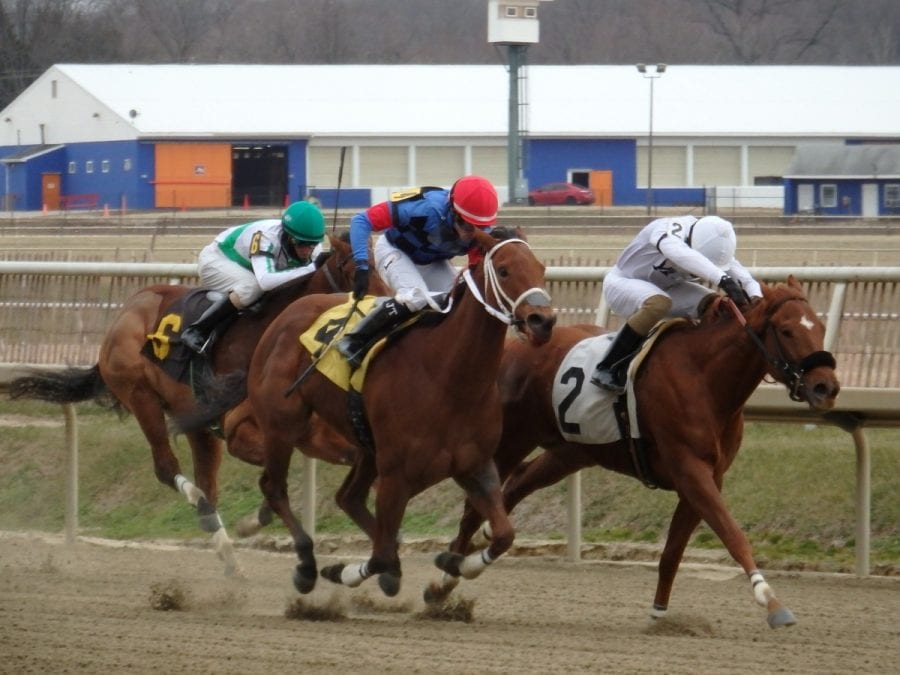Laurel: New race secretary Merz aims to “make racing best it can be”

Racing at Laurel Park. Photo by The Racing Biz.
by Frank Vespe
Ask Chris Merz what’s surprised him about moving to Maryland, and he has a ready answer. Well, make that two ready answers.
One surprise, the San Diego native says, is “how green everything is,” versus the varying shades of brown of Southern California.
Another difference: “How everybody’s into horse racing,” he said. “Racing just in general and the horse, and that’s been so cool being able to drive around, seeing horse stickers on every car.”
It constitutes a helpful reminder. “You know you’re fighting for something,” he added.
Merz, 27, is the new racing secretary at the Maryland Jockey Club, after having worked primarily at Santa Anita in recent years. Yet, while it’s important to know that you’re fighting for something, what will ultimately determine how successful he is in that role will be how he navigates something else brand-new to him: the fierce mid-Atlantic competition among racetracks for horses, and horsemen.
“Santa Anita is on an island,” Merz explained. “To be honest with you, I’m walking into something that I’m not familiar with, the competitive nature of that.”
Other than fair meets, the nearest racetrack competing with Santa Anita — that is, owned by a company other than the Stronach Group and racing at the same time — is Turf Paradise. in Phoenix, some 370 miles away.
By contrast, within a, say, four-hour drive of Laurel are Charles Town and Penn National, Parx Racing and Delaware Park, Monmouth Park and Aqueduct and Belmont, and in 2019, Colonial Downs. That’s a lot of competition at a time when the number of racing Thoroughbreds is declining — and is expected to continue to do so.
Merz, whose first day of work was June 29, replaced longtime Maryland racing secretary Georganne Hale, who moved into the newly created position of Vice-President of Racing Development. Hale, who has worked at the Maryland Jockey Club since 1984, had served as racing secretary since 2000.
As a newcomer to Maryland, and a first-time racing secretary, Merz will be leaning for assistance on Hale, Maryland Jockey Club president Sal Sinatra, and other folks in the racing office — “This is a fantastic racing office,” Merz said. “They get it. They know what’s at stake” — like Jillian Tullock and stakes coordinator Coley Blind.
In the longer term, of course, Merz has ideas of his own that he hopes to implement.
“We’ll be looking at the common-sense type of things,” Merz said. “I just feel horse racing as a whole would be better if everybody worked together, but everybody is just trying to grab their own share.”
That means, he said, trying to work with other tracks to promote greater coordination. It might also mean culling some of the many lifetime conditions that have proliferated in recent years.
That latter move might mean butting heads with horsemen, who constantly hunt for the easiest spots. That’s led to a proliferation of “lifetime” conditions — all the way up to never-won-five races — as well as what Merz calls “wonky” starter allowances that combine price and wins requirements. Both are increasingly common at tracks throughout the Mid-Atlantic, meaning that culling them — without harming his own track — will require Merz to get buy-in from the region’s other tracks and his own horsemen.

Chris Merz. Photo by Jim McCue, Maryland Jockey Club.
“With all these conditions, it’s a little bit of a challenge,” he said. “All these conditions are cannibalizing some of your other conditions, your one-other-thans, your open claiming. We really have no open claiming ranks at all. That’s bread-and-butter as far as racing goes.”
Another challenge, especially relevant as Maryland has added racing days in recent years, is to keep local trainers at home.
“It gets tough when you get the charts from the previous day and you start highlighting, ‘Oh man, this horse could have made an eight here,” Merz recounted. “That kind of jolts you the wrong way.”
Of course, how to keep trainers at home is the age-old conundrum: vinegar or milk?
The answer likely will be a combination of the two: leaning on trainers to keep them on the grounds while at the same time trying to make it more attractive for them to do so.
One program of the latter type that Merz initiated at Santa Anita was the track’s “ship and stay” program, which provided bonuses to horses that hadn’t raced in California in the prior year, with those bonuses continuing through the horse’s first three local starts.
According to Merz, the program helped spur over 140 horses to travel to Santa Anita, and they combined to make about 400 starts there.
“The best part of it is, probably about 85 percent of those horses stayed on the grounds,” Merz said. “At times they were the diifference between a seven-horse field and an eight-horse field.”
Merz said he hopes to bring a similar program — “with its own little twist” — to Laurel once turf season is over.
He said he may also seek to create programs that reward smaller trainers, both as a means of helping them remain viable and to encourage them to increase their stock. Yet a third idea is simpler yet: to let some of the better quality dirt allowance races to go with short fields.
At some level, Merz said, racing’s future may need to entail something of a return to its past. These days at most tracks, the condition book — once the horseman’s Bible — is more of a suggestion than a prescription. With races in the book, plus substitutes, plus extras on the overnight, each racing office is choosing its races each day from a couple dozen opportunities. That makes it hard for trainers to plan or train.
“The first goal here is to write a condition book where you can open the book and know the race is going to go,” Merz said. “People can open up the condition book and have the confidence that that race will go. I think that will stop a lot of the shipping.”
Merz grew up not exactly in but perhaps on the fringes of the racing industry. His family has owned horses — “just little claimers here and there,” he said — since he was a kid.
Those experiences led him to want to enter the racing industry. As a youngster, he thought he wanted to be a jockey, “But I liked food too much.”
Later, he thought perhaps he’d be a trainer or a veterinarian — so he could be hands-on with the horses — and at the University of Arizona took the Racetrack Industry Program focusing on “the animal science side.”
But eventually, he turned away from that path and towards the racing office. Since graduating, he’s served in a variety of roles at the three Southern California racetracks, Santa Anita, Del Mar, and Los Alamitos.
“My whole thing is, I want to try to make racing the best that it can be,” Merz said. “I figured the best way I could do that was to work in the racing office and change things that way.”
Now — sooner, perhaps, than he anticipated — he’ll have a chance to do just that. Some will wonder if, at his young age, he’s ready for the challenge. But Merz isn’t worried about that.
“If I just keep doing what I’m doing – coming in and working as hard as I can – I think people will see, this kid works really hard. Don’t let the age fool you.”







